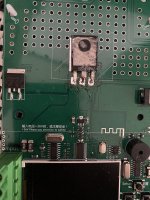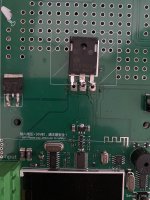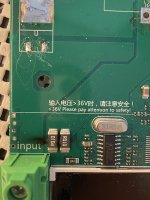I received my 180W DL24P a little over a month ago and It's been woking great testing LiFePo4 cells at cell levels. I went to test the capacity of a 22S 74V 20Ah LiFePo4 battery this morning. I heard a pop with a spark when I hit the Start button. I had cutoff set at 55V (2.5V/cell), discharge current set at 2.3A (below limit of 180W/74V=2.43A).
The spark was in the vicinity of the two R010's on the circuit board where it got blackened. Both R010's are open circuit. I suppose they are current shunts? I checked the 2 power devices, a MOSFET and a Schottky diode, both were shorted (MOSFET shorted between Drain and Source). The MOSFET and Schottky diode I was able to find on Aliexpress. What about the two R010's? What's the p/n? W/o being able to get two R010's, I will not attempt to repair it.
Has this happened to anyone else and were you able to fix it? I wonder if this failure is covered under warranty? I wrote to Atorch. Waiting for a response.



The spark was in the vicinity of the two R010's on the circuit board where it got blackened. Both R010's are open circuit. I suppose they are current shunts? I checked the 2 power devices, a MOSFET and a Schottky diode, both were shorted (MOSFET shorted between Drain and Source). The MOSFET and Schottky diode I was able to find on Aliexpress. What about the two R010's? What's the p/n? W/o being able to get two R010's, I will not attempt to repair it.
Has this happened to anyone else and were you able to fix it? I wonder if this failure is covered under warranty? I wrote to Atorch. Waiting for a response.










